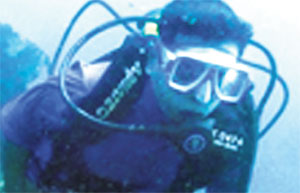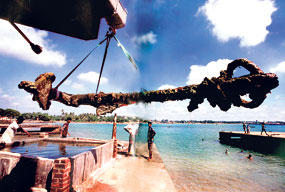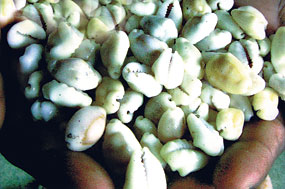
Diving into the waves of timeMarine archaeologists are striving to unravel and conserve an integral part of our history that lies buried deep in our seabed Even as 96 years after, scientists are intrigued as to why the ‘Titanic’, the “unsinkable” ship sank on its maiden voyage after hitting an iceberg off the coast of Newfoundland on a freezing, moonless night, marine archaeologists right here in Sri Lanka are attempting to unravel the mysteries surrounding some unique shipwrecks buried under the waves of time. While the western world debates whether weak rivets were the cause of the Titanic’s doom, Sri Lankan marine archaeologists are also getting into deeper water not only to gather as much information as possible on the island-nation’s maritime heritage but also to protect them from looters who rob valuable artifacts from shipwrecks and plunderers who strip them of their iron.
How many know of the treasures of the sea that are spread around this country? “Only in those particular areas, do people know,” says Central Cultural Fund Deputy Director-General Dr. Mohan Abeyratne. Did the wooden craft, now lying very close to the Ambalangoda coast just 20 metres away, carry pearls? Kata katha (rumour and speculation) in the area are rife that there were strange cannons wrapped in rope. The pearls are no more as are the parts of the cannons. Speculation apart, what has been unearthed is ‘money cowrie’ (kawadi salli) which was used for barter in times when money was not in circulation, says Dr. Abeyratne, while Senior Research Officer and Maritime Archaeologist Rasika Muthucumarana adds, “The craft was most probably Indian or French.” Although we did a few days exploration in the late nineties, regrettably we didn’t have equipment for excavations, says Mr. Muthucumarana. Early 2007, saw the Coast Conservation Department taking up the dredging of the Ambalangoda fisheries harbour, and copper plates with Arabic inscriptions have been unearthed, he explained. Adds Dr. Abeyratne that when any development project is undertaken on land or sea, in an area which has archaeological sites, 1% of the project funding has to be given for an impact assessment to be carried out by the CCF. “This is a requirement under the Antiquities Ordinance,” he stresses, explaining that the CCF is still awaiting that 1% for exploration in Ambalangoda from the Chinese contractor. Further along the southern coast, at the bottom of the sea off Hikkaduwa lies the very first oil-tanker, ‘S.S. Conch’, to be built in the world. This steamship, built by the British in 1892 and owned by Shell Company had been wrecked in 1903. “Until a few years ago, when some people attempted to secure a permit to strip the iron off this vessel and the hoteliers and a few concerned people in the area took up its cause, no details were known about it,” says Dr. Abeyratne, lamenting the fact that Sri Lanka did not have the capacity for underwater excavation, explorations and conservation till very recently. The hoteliers knew of it because recreational diving was going on there and tourists were being shown this piece, he adds.
Two more wrecks in Akurala, the ‘Earl of Shaftsbury’ and another earlier unidentified wreck but now recognized as ‘Victory’ were the hands-on training sites for a group of trainers under a recent agreement signed with UNESCO to set up the Asia-Pacific School of Underwater Archaeology at the historic Galle Fort. Not only will it be a training centre but also a centre of excellence for archaeology and oceanography, Dr. Abeyratne says. The ‘Earl of Shaftsbury’, a steel-hulled sailing ship had been wrecked in Akurala at a time it was carrying coal in 1893. “Sadly, it had been dynamited by unscrupulous persons,” said Mr. Muthucumarana. The fate of ‘Victory’ too would have been questionable, it is learnt, as some persons had sought a permit even producing affidavits that it was the wreck of the trawler ‘Asuki Maru’ which sank only around 20 years ago, in a bid to strip off its iron. However, those challenges had been overcome and ‘Victory’ has now been identified as a steamship of a 100-year vintage. While marine archaeologists were donning diving suits and exploring the ‘Earl of Shaftsbury’ and ‘Victory’, the first Steering Committee meeting of the Field School had also been held in April at Unawatuna with the participation of representatives from UNESCO, the Philippines, Thailand, India, Australia, Indonesia, the Netherlands, the United Kingdom and France. Davy Jones treasures in Galle alone, underwater surveys have revealed, come from 26 archaeological sites dating from the 13th to 16th century to modern times……with such artifacts as Indian-Arabian stone anchors including one from the Arabian peninsula weighing almost a tonne and a celadon bowl of the Southern Song dynasty (13th century) indicating that Sri Lanka was an important meeting point for shipping as well as trade routes. Of course, the most famous shipwreck of Galle is Avondster (Evening Star), found very close to shore in shallow waters. The wreck was identified as the 17th century East Indiaman Avondster which had been in the service of the Dutch East India Company (VOC) in the 1650s and had “in a light breeze slipped from her anchors and because of bad supervision perished” (found in VOC, Letters and papers from Asia). Something “odd” about the construction of the ship, however, had made the archaeologists delve deeper into history to come up with the fascinating fact that the ship had been brought into the service of the VOC in 1653 after capture by the Dutch from the English East India Company in Persian waters. At capture its name had been ‘Blessing’. According to detailed records put out in the form of a beautiful book by the Centre for International Heritage Activities, the vessel’s exact age is unknown. Firstly known as the ‘John and Thomas’ it had been bought by the British East India Company in 1641, renamed ‘Blessing’ and dispatched to Java, later deployed increasingly in regional trade. “The starboard side (rightside) of the Avondster had been preserved well, because at that time there had been a canal flowing into the Galle harbour, now long gone, the mud from which had covered the wreck,” says Mr. Muthucumarana. Dr. Abeyratne adds: “We are now carrying out in-situ conservation which will prevent natural erosion and scouring caused by the sea and weather; objects being moved all over the site; wood degrading organisms; looting; fishing activities and chemical degradation.” Be it the ‘S.S. Conch’, ‘Victory’ or ‘Avondster’ an integral part of Sri Lanka’s history falls into place, with the discovery and recovery of our maritime heritage, sunken and buried for centuries in the ghostly caverns of shipwrecks and the seabed. A chance discovery leads to maritime heritage It was a chance discovery in 1961 near the Great Basses lighthouse in Kirinde by Mike Wilson and two companions that gave a pointer to the wealth under the sea around Sri Lanka. What did they find? It was a wreck which held in its depths among other artifacts sacks of Moghul silver coins dating back to 1702 AD minted in Surat, India. A flurry of diving expeditions took place with eminent persons such as the late Arthur C. Clarke (he wrote a book ‘The Treasure of the Reef’ in 1974) and the late Rodney Jonklaas making an impact on treasure and artifact recovery from under the sea, says Dr. Abeyratne. Though no one knows the details of how some of the artifacts and bundles of silver coins from the Great Basses wreck made their way to the far-off Smithsonian Institution in Washington, US, across the seas, they opened the eyes of the world to the maritime heritage of Sri Lanka, he says. The new Maritime Museum being established in Galle would be the richer if some of the Moghul silver coins and at least replicas of artifacts recovered from the Great Basses wreck could be conserved there, says the CCF’s Deputy Director-General adding that the expertise of the preservation techniques as practised by the Smithsonian will also come in handy for Lankan conservators. Lamenting the fact that during the early times when Lanka’s maritime heritage was being discovered the general belief was that finders could be keepers and underwater treasures were also destroyed or sold illicitly, Dr. Abeyratne said that now regulations are in place. “We also don’t need to take all the artifacts out of the wrecks, we can develop ocean museums, he says, revealing plans to categorize all wrecks around the country into:
Sri Lanka needs to show off its maritime heritage but also ensure that it is preserved for posterity, he stresses, adding that even two weeks ago silver coins were found at the Great Basses. |
|
||||||
|| Front
Page | News | Editorial | Columns | Sports | Plus | Financial
Times | International | Mirror | TV
Times | Funday
Times || |
| |
Reproduction of articles permitted when used without any alterations to contents and a link to the source page.
|
© Copyright
2008 | Wijeya
Newspapers Ltd.Colombo. Sri Lanka. All Rights Reserved. |


